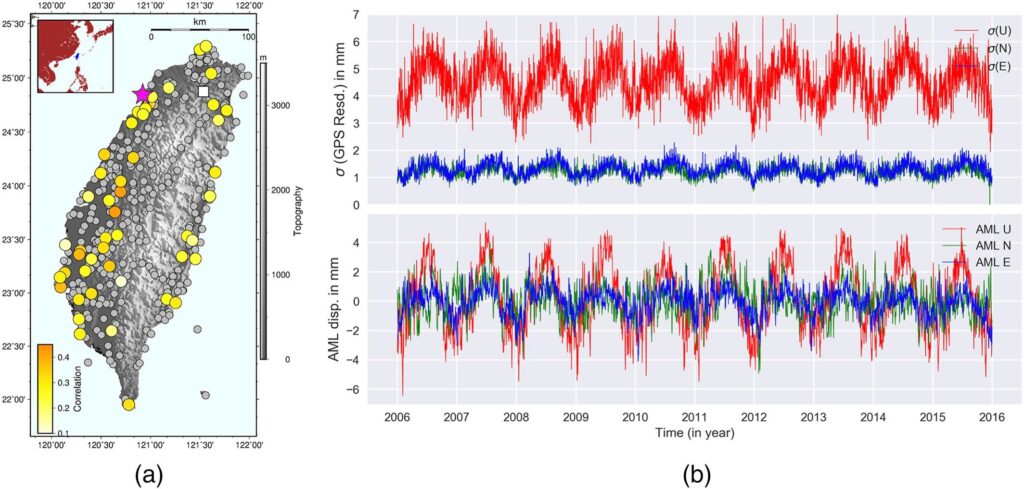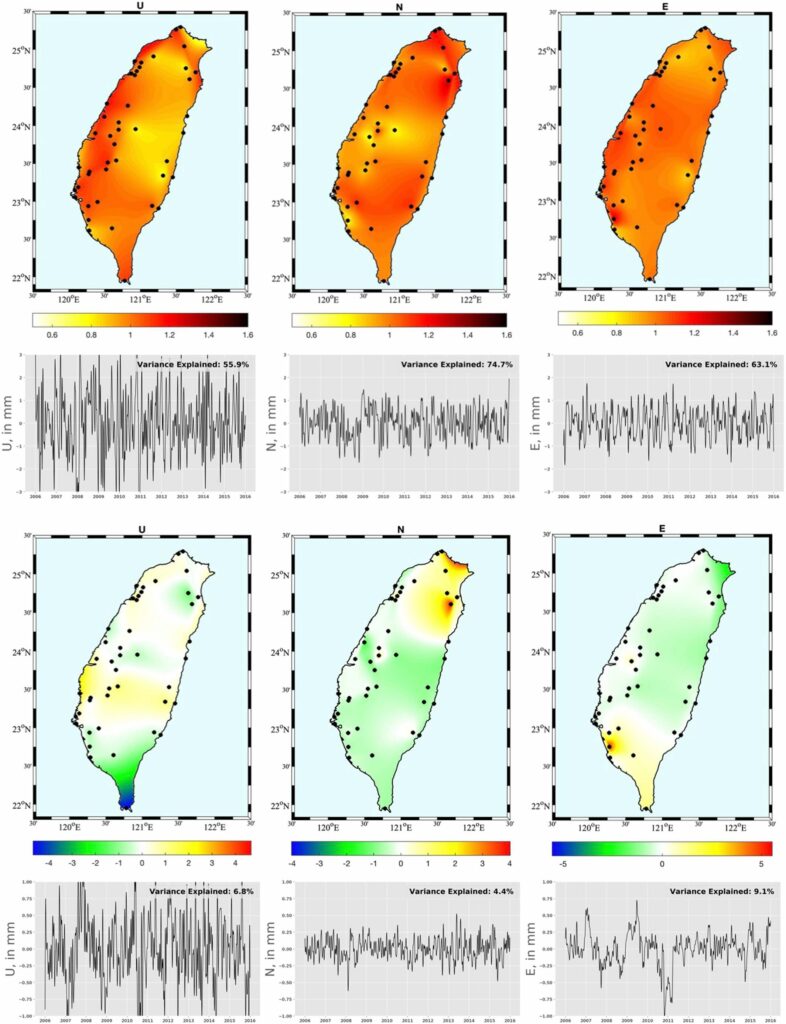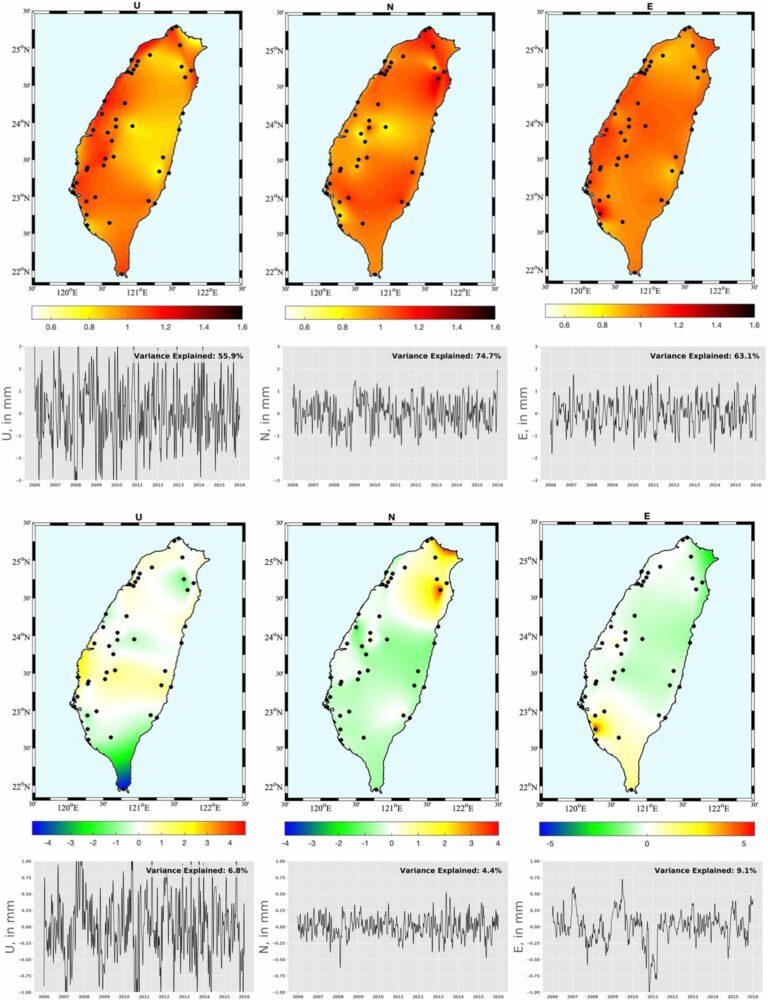Introduction
In the field of geophysics, the precision of Global Positioning System (GPS) data is paramount for understanding a wide range of Earth processes, from fault motion detection to postseismic deformation. However, systematic errors, particularly the common-mode error (CME), can obscure these insights. In our study, titled “What Causes the Common‐Mode Error in Array GPS Displacement Fields: Case Study for Taiwan in Relation to Atmospheric Mass Loading,” we delved into the origins of CME using a dense network of GPS stations in Taiwan. Our findings not only shed light on the sources of CME but also underscore the significant role of atmospheric mass loading (AML) in influencing GPS measurements.
Background
Common-mode errors are systematic errors in GPS data that exhibit strong spatial coherence across a network of stations. These errors, if not properly accounted for, can contaminate the interpretation of geophysical phenomena. Previous studies have suggested that these errors might be influenced by various environmental factors, including atmospheric, hydrological, and oceanic loads. However, the specific contributions of these factors, particularly atmospheric mass loading, had not been fully quantified until now.
Methodology
To investigate the origin of CME, we analyzed 10 years of GPS data from 47 selected stations across Taiwan. The data was meticulously processed to ensure high quality, with particular attention given to the vertical, north, and east components of the displacement fields.
Empirical Orthogonal Function (EOF) Analysis
We employed the Empirical Orthogonal Function (EOF) analysis, a robust technique akin to principal component analysis (PCA), to extract the CME from the GPS displacement data. This method allowed us to segregate the CME as the leading mode, which represents the most significant spatially coherent signal across the network.
Atmospheric Mass Loading (AML) Data
The AML data was obtained from the NASA Goddard Space Flight Center, providing detailed displacement fields for Taiwan. This data was critical in evaluating the impact of AML on the GPS measurements. By correlating the extracted CME with the AML data, we sought to understand the degree to which AML contributes to the observed errors in GPS displacement fields.

Results
Our analysis revealed several key findings:
CME Extraction and Correlation with AML
The EOF analysis showed that the first mode, which represents the CME, captured 56% of the variance in the vertical component of the GPS data. Notably, we found a significant correlation between the CME and AML residuals, particularly in the vertical component, with a correlation coefficient (ρ) of 0.43. This strong correlation indicates that AML plays a substantial role in influencing the CME, especially on a monthly timescale.

Regression Analysis
Further regression analysis between the CME and AML residuals revealed an admittance factor of 0.93, suggesting that up to 90% of the CME variations can be attributed to AML in the vertical component. This finding is crucial as it quantifies the impact of AML on CME and provides a pathway to correcting for these errors in GPS data.
Discussion
The implications of our findings are significant for the geophysical community. By establishing a strong link between AML and CME, our study provides a framework for improving the accuracy of GPS data analysis. The results suggest that by accounting for AML, we can significantly reduce the CME in GPS displacement fields, leading to more precise measurements of Earth’s processes.
However, our study also highlights certain limitations. The AML data used in this study, while comprehensive, has a spatial resolution limit that may affect the precision of the correlation with GPS data. Additionally, our focus on the vertical component leaves room for further exploration of the horizontal components and their relation to other environmental factors.
Conclusion
In conclusion, our study demonstrates that atmospheric mass loading is a significant contributor to the common-mode error in GPS displacement fields in Taiwan. By applying EOF analysis and correlating the results with AML data, we have provided a detailed understanding of the sources of CME. These insights are invaluable for enhancing the precision of GPS-based geophysical studies and offer a pathway to mitigating the impact of CME in future research.
As we continue to refine our understanding of these errors, the potential applications of this research extend beyond Taiwan, offering implications for GPS networks worldwide.
References
For readers interested in exploring the detailed methodology and results of our study, the original paper can be accessed here. We also encourage readers to review the supporting literature cited throughout this post, including key studies on GPS data processing and atmospheric mass loading.
[zotpress items=”{9687752:ZD3THVWQ}” style=”apa”]

